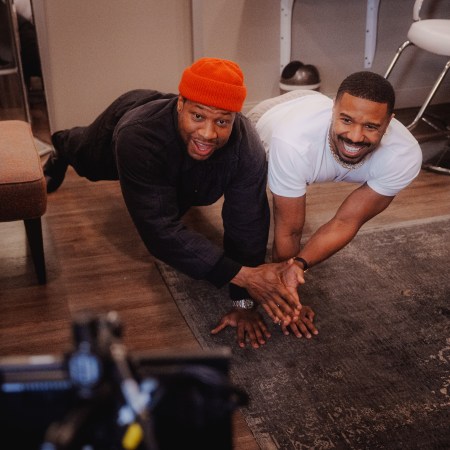Welcome to The Workout From Home Diaries. Throughout our national self-isolation period, we’ll be sharing single-exercise deep dives, offbeat belly-busters and general get-off-the-couch inspiration that doesn’t require a visit to your (likely now-shuttered) local gym.
An old cross country buddy texted me yesterday. He lives in San Francisco with a friend, and has been trying to adjust to the city’s shelter-in-place quarantine over the last few days. Some initiatives have gone well — they’re on the 28th episode of the third season Love Island — while others, like his roommate buying a $67 yoga mat that’s still yet to see a single use, have not.
Out of “sanity necessity” he wrote, he’s started a daily “golden hour to Golden Gate run,” right around 6:45 p.m. He told me he’s been running with a consistency he hasn’t since our days on the team (that was about nine years ago) and finds himself even looking forward to it.
I’m on another coast, hunkering down in a sleepy New Jersey town about 20 miles outside Manhattan, but I’m right there with him. Running is a rare luxury right now, one of the few activities left that removes that unsettling inkling that we’re all being pushed around — from the bedroom to the living room to panic-stricken grocery store — like characters in a video game simulation.
It’s a failsafe answer, too, to the now-daily “What should my workout look like today?” query. The fitness community has stepped up admirably this week, weathering planet-wide gym closures with a steady stream of Instagram content, free six-week wellness app subscriptions and livestreamed nightly meditation sessions. But it’s nice, once in a while, to not sweat in the same space you’re sending emails from all day, or where your kids are building Lego villages. And as long as you practice appropriate social distancing (remain six feet away from other people, don’t sneeze on a public water fountain), you’re still okay to run outside. The San Francisco County health department’s order even seemed to encourage it.
Which is all to say, the world will probably have a few more runners (or born-again runners) once we reach the other side of this thing. If you happen to find a similar consistency with the activity as my friend out in the Bay, it’s likely you’ll switch things up as you explore: new routes, varying speeds, workouts like tempo runs and fartleks, recovery runs. They’re all worth your time. Go with whomever you’re riding this thing out with, or don’t — we could all use a break — and put on a playlist or podcast. But whatever you you do, I recommend that at some point you find the biggest, baddest hill in the neighborhood and run straight up it.
I’m talking about the hill that one sixth grader breaks an arm on each year in an unauthorized soap box derby. The hill that necessitates emergency break parking. The hill that even the hardest weekend-warrior cyclists don’t bother attempting. (In more quantifiable terms, the hill should take about 30 to 45 seconds to summit at a sprint; this will translate to about 100 meters for most.) Head to whatever your version of this hill is; if it’s nearby, jog over as a warmup, if it’s far away, drive over and run a couple circuits in the nearby vicinity. Then run up it, as fast as you can. Jog back down. Take a couple minutes to rest. Do it again. Sprint up it a total of four times, do a cool-down jog, then go home. That’s a hill workout.
During my cross country days, we’d do some type of hill workout once a week. New Jersey has some notoriously hilly courses. The last half mile of one of our “home” courses was directly uphill, while the State Meet of Champions is held annually at infamous Holmdel Park, where the first mile is comprised of manic “hoop-dee-doos” (little rollercoaster hills) and the middle mile includes a dreaded, roundabout hill called “The Bowl.” Other than training for these courses, we didn’t do hill workouts for any explicit reason. The coaches just taught, and we all implicitly understood, that sprinting up hills made you a stronger runner, both physically and mentally.
Of course, few people in the running world, and virtually no professional runner or trainer, still does something “just because.” There are stats and studies to back up or disprove every popular training regimen, and hill workouts definitely get the former. Sprinting up a hill boosts muscle strength and lactate threshold while improving a newer metric we’re still learning more about called “running economy.” Basically, it’s a measure of how you use energy when running at a certain intensity. The more time you spend sprinting up hills, the better your body gets at knowing how (and when) to send oxygen to your muscles. Running up hills also refines biomechanics, forcing you to sprint with shorter, concise strides, instead of overextending outwards (which can expose joints to injury).
I was pumped, if unsurprised, to learn the scientific benefits of running hills. At the same time, an old-school part of me also didn’t even care. Hill workouts have long been a runner’s mental toughness gut-check. When you come upon a hill in a race, what are you going to do? The great ones eat them, like great basketball players calling for the ball when the shot clock’s running down. It’s tempting to conserve energy when running up a hill, to bank on speeding up on the downhill, but not only is that dangerous (your stride should be controlled, with your chest bracing forward — swinging your legs forward wildly is a great way to get injured), it’s also probably not the best strategy.
We don’t have many opportunities to test our mental toughness these days. There are ways to challenge yourself in that arena, like joining a boxing club or spending $90 to climb over obstacles covered in mud, but even if those were available to you right now, they’re extremely public activities. Running up an incline, meanwhile, is a personal activity. It’s you versus you. You’re going to finish it one way or another, and the pain you feel, assuming you’re not running on a bum leg, only serves to make you stronger.
As you head out on the roads over the next couple months, laces tied tight in search of that “sanity necessity” my buddy wrote about, find a hill and create a metaphor in your brain. Maybe the hill is just your fitness journey, maybe it’s the frustration you feel about an unused yoga mat taking up space in the living room, maybe it’s literally the coronavirus. Take a deep breath and sprint up that thing. If you don’t like what you learn about yourself on the way up, don’t worry — it’ll still be there tomorrow, offering you a chance at redemption.
This article was featured in the InsideHook newsletter. Sign up now.


















